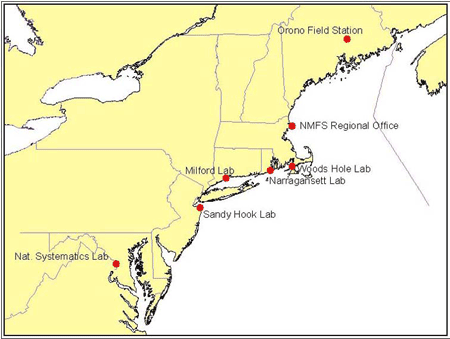The Northeast Fisheries Science Center
is the research arm of NOAA Fisheries in the region. The Center plans, develops, and manages a multidisciplinary program of basic and applied research to: (1) better understand living marine resources of the Northeast Continental Shelf Ecosystem from the Gulf of Maine to Cape Hatteras, and the habitat quality essential for their existence and continued productivity; and (2) describe and provide to management, industry, and the public, options for the conservation and utilization of living marine resources, and for the restoration and maintenance of marine environmental quality.

The functions are carried out through the coordinated efforts of research facilities located in Massachusetts, Rhode Island, Connecticut, New Jersey, and Washington, DC.
The James J. Howard Marine Sciences Laboratory, located on the New Jersey shore at Sandy Hook, is a state-of-the-art marine research facility shared by the National Oceanic and Atmospheric Administration (NOAA) and the State of New Jersey. Federal research at the laboratory is conducted by NOAA's National Marine Fisheries Service (NMFS).
The primary mission of the Howard Laboratory is to conduct research in ecology, leading to a better understanding of both coastal and estuarine organisms and the effects of human activities on nearshore marine populations.
The Milford CT Laboratory, established in 1931, is located on the shore of Long Island Sound. The facility is comprised of two laboratory/office buildings and support buildings housing raceway and circular tanks. A 49-foot vessel, the R/V Victor Loosanoff, is also docked at the Laboratory for nearshore research.
Present research emphasizes aquaculture and habitat-related work. A well-integrated aquaculture program includes studies of the culture of fish and shellfish to develop methods suitable for commercial use as well as for stock enhancement and restoration. Nearshore habitats are being studied to determine what characteristics make a habitat suitable for a particular species.
The Narragansett RI Laboratory is located on three acres of federally owned land on the Bay Campus of the University of Rhode Island (URI). It is adjacent to URI's Graduate School of Oceanography and the National Health and Environmental Effects Research Laboratory of the Environmental Protection Agency (EPA). The facility consists of one main building and aquarium, and four adjacent office/laboratory modular buildings. The laboratory is a facility with a specialized staff of 50 supported by advanced oceanographic and biological systems for carrying out research on the effects of changing environmental conditions on the growth and survival of fish stocks from an ecosystems perspective.
Research is conducted on the effects of changing oceanographic and ecological conditions on the productivity and health of the Northeast U.S. Continental Shelf ecosystem in relation to the recovery of depleted fish stocks. Studies are also conducted on the demography and ecology of shark populations in response to oceanographic conditions to provide information for shark management plans for sustaining those populations. The studies are conducted in support of two major objectives of NOAA's Strategic Plan - Build Sustainable Fisheries and Sustain Healthy Coasts.
The National Systematics Laboratory is administered by the Northeast Fisheries Science Center, but serves as the taxonomic research arm of NOAA Fisheries as a whole. The Laboratory describes and names new species, and revises existing descriptions and names based on new information, of fishes, squids, crustaceans, and corals of economic or ecological importance to the United States. Because some important species are highly migratory and many exotic species are introduced into U.S. waters or markets, the Laboratory's research is worldwide. Major products of this research are worldwide and regional taxonomic publications and identification guides.
The Orono ME Field Station is the NEFSC salmon research field station.
The Woods Hole MA Laboratory occupies 3.4 acres on Vineyard Sound. The facility houses both the Woods Hole Laboratory Research Divisions and the Northeast Fisheries Science Center Directorate. The Center provides overall management and direction for the five laboratories located in the Northeast Region.
In addition, Research Planning and Coordination Staff, Program Support Staff, and Data Management Systems Staff are located at the Woods Hole Laboratory. The Laboratory houses a public and research aquarium that is open to visitors year round and is also home port for two research vessels, the R/V Albatross IV and R/V Delaware II.
|